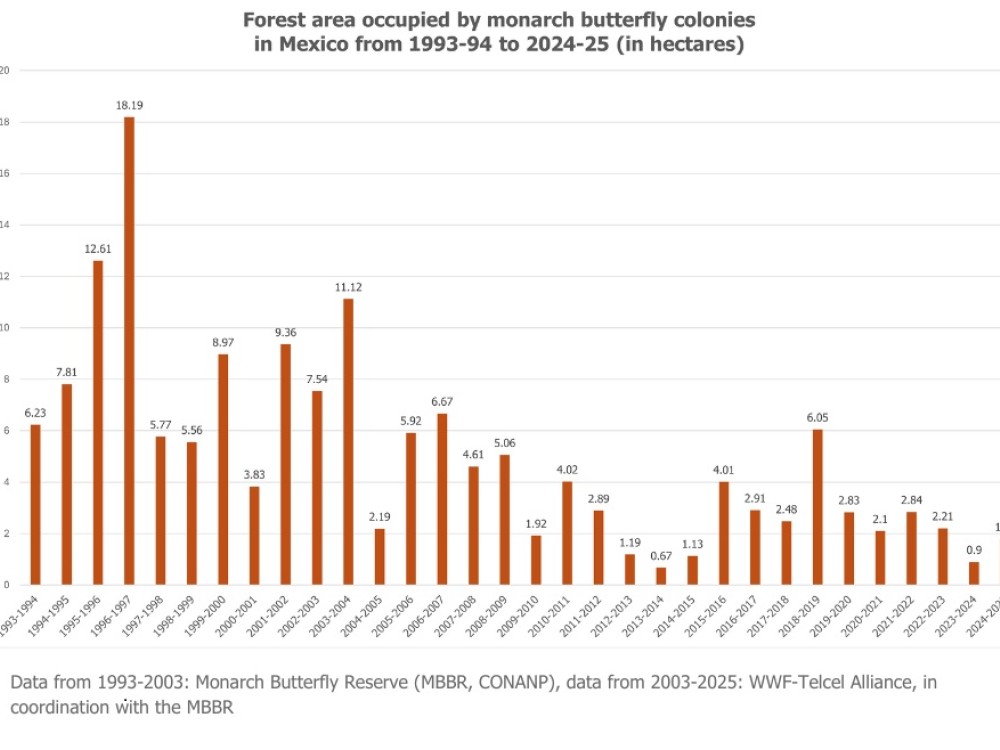Eastern monarch population count announced
Numbers are in from Mexico, with the largest jump since 2018, a 99% increase. This news update includes a note from Karen Oberhauser about the numbers, as well as updates from Gail Morris, Estela Romero and Susan Meyers.
By Karen Oberhauser, monarch researcher, retired director of the University of Wisconsin-Madison Arboretum
On March 6, the World Wildlife Fund-Telmex Telcel Foundation Alliance (WWF) and the National Commission of Protected Natural Areas in Mexico (CONANP) released data from the winter 2024–25 monarch butterfly population counts. In December 2024, monarchs occupied 1.79 hectares, compared to 0.9 hectares at the same time in 2023. This represents a 99% increase, the biggest jump since the monarch overwintering area increased from 2.48 hectares in December 2017 to 6.05 hectares in December 2018, a 144% jump. While any increase is great news, this number is still below the average for the past decade, 2.81 hectares, which is itself far less than the area when researchers first started measuring colony size in the early 1990s (see graph). The decline in their numbers led to the December 2024 recommendation by the U.S. Fish and Wildlife Service that monarchs be designated as threatened and thus receive the protection of the Endangered Species Act.
At the wintering sites in central Mexico, where most monarchs from east of the Rocky Mountains overwinter, monarch population size is compared from year to year by the number of hectares (one hectare = 2.5 acres) occupied by trees with clusters of monarchs. WWF and CONANP have been monitoring this area since 2004, with similar data from 1993-2003 collected by the Monarch Butterfly Biosphere Reserve (MBBR). While the number of monarchs in a hectare varies from year to year and is difficult to estimate, our best estimate is that it is about 21 million.
Monarch numbers are driven by factors that affect recruitment (the number of eggs that are laid and that survive to adulthood) and adult survival and successful navigation of the annual cycle of breeding, migrating, and overwintering. Recruitment and survival are affected by the availability of quality habitat, weather conditions, and the presence of lethal agents (natural enemies such as predators, diseases, and parasites; environmental toxins and pesticides; and other agents of mortality that are often difficult to quantify, such as vehicles). Thus, land conversion, climate change, and pesticide use can all affect monarch numbers.
The amount of breeding habitat available for monarchs sets an upper limit, or ceiling, for the size of the monarch population. Numbers vary under and up to that ceiling depending on weather conditions. We probably got close to the ceiling in the summer of 2018, when the colonies were the largest that they had been for over a decade.
Over the past century, many factors have affected the amount of habitat available to monarchs, and the relative importance of these factors is probably changing. In the 1800s and early 1900s, forested area in the eastern U.S. was cleared for farmland and cities, but much of that farmland has since been taken out of cultivation, and forests are recovering.
Early North American settlers in the Midwestern U.S. converted vast expanses of prairie, good monarch habitat, into farmland, but these farms tended to have small fields with milkweed and nectar plants growing on the edges, and chemical pesticides were not available. Even with the growing predominance of large, cultivated fields after the middle of the 20th century, weed control methods (usually disking) did not kill milkweed; on the contrary, most milkweed in the Upper Midwestern U.S. in the 1980s and 1990s was probably found in corn and soybean fields. Thus, early farming practices in the U.S. probably benefited monarchs; in the east, farmland replaced forests that were not good monarch habitat, and the land disturbance that accompanied agriculture promoted the growth of what became eastern monarchs’ most important food source, common milkweed (Asclepias syriaca).
In the late 1990s, the development of genetically modified herbicide-tolerant crops (first Roundup® Ready and then a series of crops resistant to other herbicides) allowed farmers to spray their fields with herbicides after the crop plants emerged, and milkweed quickly disappeared from these fields. Insecticide use to control agricultural, nuisance pests, and insects that can vector human pathogens has also increased in the past few decades (Van Deynze et al. 2024). Climate change is another factor altering the conditions for population growth as drought reduces the quality of milkweed nectar plants and the availability of nectar for migrating monarchs. Additionally, damaging storms have increased in intensity.
The best way to support monarchs is to raise the population ceiling by creating more habitat. That means restoring habitat in our yards, places of work, schools, and churches; along roadsides, utility rights-of-way, and railroads; and in areas currently used for crops that aren’t very productive. But we also need to do what we can to mitigate climate change. The conditions predicted by climate models will be bad for monarchs, but they’ll also be harmful to us and most other organisms on Earth.
Hail storm hits El Rosario
By Estela Romero, for Journey North
Feb. 24
Dear citizen science and conservationist community:
After nearly four months of stable weather, our migrating super generation has suddenly been surprised by a rather quick, semi-intense hail storm near El Rosario Sanctuary.
This winter has been only occasionally cold with scarce rain events, keeping the whole oyamel forest region at mostly several degrees above zero centigrade, rarely touching freezing temperatures. This is the first interrupting weather event registered this season.
Local guides had already left the colony on Saturday afternoon after what had been a rather cloudy day. The hail event came suddenly at around 6:30 p.m. when guides were already at home and lasted about 15 minutes.
The next day, the slightly cloudy and chilly morning quickly turned sunny. The monarch colony was closed while conservation authorities assessed possible mortality, which local guides in El Rosario now say was rather low. Monday brought a splendorous, intense blue sky and bright sun. Monarchs are flying all over and we are very happy the event did not cause a massive mortality at all.
By the time it hailed in El Rosario Sanctuary last Saturday, monarchs might have been leaving Sierra Chincua, where only some hail fell.
To the guides' surprise, on Saturday and Sunday they saw only some flying around, but not a colony or clusters anymore. On Monday, Feb. 24, all they found were some flying around at the “Las Palmas" site, where they traditionally settle prior to their leaving. Differing from former seasons, this time they hardly stayed for only a few days in this last halting site.
Should temperatures increase systematically this week, our resilient migratory monarchs may begin their gradual departure from El Rosario within the coming days.
The break point of the decline of the season is now happening, but, meanwhile, El Rosario Sanctuary may still surprise us with extraordinary performances of thousands of individuals clouding the sky while flying, nectaring and mating all over.
March 4
The massive departure for the season has been occurring over the entire past week.
At Sierra Chincua Sanctuary, the migrating population actually left the site a couple of days before the hail storm in El Rosario Sanctuary occurred on Feb. 22. Ten days later, at the magnificent view-point site of “Las Palmas,” 19.6719953 -100.2997587, traditionally their last halting point before departure, only the very last remaining of the population are flying at the impressive cliff and valley, the grand door to the great migration.
The El Rosario colony has importantly reduced now. It is still at its very same site 19.5985786 -100.2610105 but clearly orientating northwest, a considerable massive departure has been occurring for the whole past week up to now, once the hail event passed and temperatures immediately increased reaching up to 24-26°C.
So far, rather scarce mating is seen and considerable perishing numbers are evident on the ground along closed trails and between the weeds.
It has been an overwintering season with a delayed arrival to our oyamel fir forests and a fluctuating concentration for El Rosario Sanctuary until halfway through the season.
Different efforts to assist the great migration are made throughout the migration's three hosting nations.
Among them, education on general and unfamiliar aspects that surround monarchs’ ecosystems is key for our extraordinary species’ protection to reach present and future generations in towns and villages that shall guard their breeding regions and their unique winter refuge.
The Symbolic Migration Program, a partnership project between Journey North and Monarchs Across Georgia, will celebrate its 30th anniversary next fall as the only persevering educational program delivering education on conservation through the exchange of symbolic paper butterflies and letters between students at such regions for nearly three generations in the three countries.
Thank you for your support and participation during these three extraordinary decades of learning, fraternity and mutual gratitude across borders!
Estela Romero
Journey North
Angangueo, Michocán, México
Estela Romero is an environmental educator with Monarchs Across Georgia. Reporting from Angangueo, Michoacán, Estela Romero's work is made possible by funding from Monarchs Across Georgia and the Monarch Butterfly Fund. Estela Romero es educadora ambiental de Monarchs Across Georgia. Informando desde Angangueo, Michoacán, el trabajo de Estela Romero es posible gracias a la financiación de Monarchs Across Georgia y el Monarch Butterfly Fund.
Symbolic Migration wraps up for the season
By Susan Meyers, Monarchs Across Georgia
All Ambassadors that we received have been delivered in Mexico! Estela Romero is composing the final blog posts this week.
To find your Ambassador, use the search bar at the top right of the page on https://symbolicmigration.org/ to enter your city, school or organization name.
We have the letters from the students in Mexico and have already started to send out the spring return envelopes. Envelopes to participants in Canada and the states of Washington, California, Utah, Arizona, Colorado, North Dakota, Kansas, Oklahoma and Texas are already on their way via USPS.
Our goal is to mail all spring return envelopes by mid-March. This should ensure that you receive yours by the first week of April if not sooner. Questions? Contact symbolic-migration@eealliance.org. Remember to report your sightings of real monarchs to Journey North!
The Symbolic Monarch Migration project is a partnership project between Journey North (a program of the University of Wisconsin-Madison Arboretum) and Monarchs Across Georgia (a committee of the nonprofit organization, the Environmental Education Alliance). Journey North hosts educational materials on its website. Monarchs Across Georgia administers the project including coordinating the exchange of symbolic butterflies among 2000+ classrooms in three countries, engaging a contract worker to provide lessons and deliver materials in Mexico, and raising funds for the project's continuation.
The Monarch Butterfly Fund continues to support our Mexico Book Project through their Small Grants program. Books purchased with grant funds supplement environmental education lessons facilitated through our Symbolic Monarch Migration project.
Western monarch update
By Gail Morris, Southwest Monarch Study coordinator
Reports from the Field
Monarchs at the California overwintering sites are few in number as they leave and disperse through nearby areas. Rain is in the forecast in many surrounding areas this week, which may limit their movement but improve the condition of emerging milkweeds ready for their eggs and larvae.
This time of year is when the number of monarchs is lowest. Their success in mating, laying eggs and favorable conditions for their life cycle offer the hope of an expanding monarch population as the season progresses. Similarly, this is the time of the smallest number of reports since monarchs are traveling as singletons and often are not seen. So, if you are out and about, be sure to check each milkweed you see for eggs and larvae and report your findings.
Diana Magor, Santa Cruz, California
March 4
I do have a native milkweed up, and ready to flower. It’s Asclepias cordifolia, native to northern-central and northern California, in the Cascades, southern Oregon and the Sierra Nevada as far south as Bakersfield.
I’ve been studying this species for about two years now and experimenting with various methods of propagation. Its main virtue is that it emerges very early from the ground – as soon as Jan. 1 in the northern Coast Range south of Lake Berryessa.
Tom Landis and I have collected seeds there with a permit, and have sent seeds out to a few native plant nurseries, such as The Watershed Nursery in Albany, California. They have had excellent results propagating and we have successfully grown, with the help of Lisa Damerel, Contra Costa County RCD, a few of their seedlings in Concord, California.
I believe that this plant and the other early-rising California milkweed, Asclepias californica, should be promoted for habitat restoration, RCDs and butterfly gardens to provide milkweed for female monarchs leaving overwintering sites earlier than they used to due to climate change. Last year when I had more of the heartleaf milkweed, the females oviposited so many eggs on this species that the larvae pretty much ate all the leaf material and then went for the stems. I don’t have many this year.
Neighbors and I are seeing monarchs in our gardens every day since the warm temperatures arrived and Lighthouse Field overwintering site colony breakup a few days ago. A chrysalis that’s been hanging from my handrail since at least Jan. 23 just closed on Feb. 24 and I have only one caterpillar (4th instar) left feeding on milkweed in a large container that has survived the garden predator.
On Sunday, March 2, Diana shared another short update. "Just found a freshly laid egg in my garden yesterday. Still about 20 males at LF site."
Feb. 25
At Lighthouse Field on Feb. 21 at 8:30 a.m., one of our team, Liana Crabtree, counted 192 monarchs. The temperature was 50°F at start, to 54° at end, partly overcast. The majority, 163 monarchs, were clustered on the west side of cypress tree #12, with 18 on cypress #7 inside the grove, six on the sunny east-side eucalyptus, and three on the cypress east of the grove. As the temperature warmed, there were seven flyers.
The previous evening, Feb. 20 at 4:35 p.m., I observed and photographed the aggregation and found 144 in the grove, including 10 flyers, four nectaring & one mated pair.
At 5:07 on a west-facing cypress tree east of the grove, I counted 60 sunning on the west-facing side, 12 on an adjacent eucalyptus and approximately 10 flyers. There was much movement toward the higher branches and the sunniest spots as the sun began to sink toward sunset. At 5:19, there was a major movement toward the main grove and by 5:30 at least 200 were on tree 12 (west branches in the grove, many sunning, with only eight on the outside cypress. I observed a few flying toward the east-facing eucalyptus inside the grove. There were only seven on cypress tree 7 inside.
At 5:40, pretty much all were settled and closing wings, and by 5:45 all flying had stopped except for one. The grove was in the shade just before sunset. The temperature at 5:50 was 56.2°F.
Although I searched my photos diligently, I found no females except for the two mating on Feb. 20.
Since about 90% of the monarchs were photographed with wings open, I would have seen females if they’d been there. I conclude that almost all the females have dispersed, so I am concluding our weekly counts. It is common to find males in aggregations at overwintering sites after the females have departed.
On Feb. 22, on a very warm 73° afternoon, I observed two monarchs in my garden two miles north of Lighthouse Field and a few were also reported at the neighborhood preschool on Western Drive, a little farther north.
I have visited LF every day for the last few days. As mentioned in my recent report, there were just under 200 counted on Feb. 21. That count was followed by two mostly sunny and very warm days (73°F). Yesterday, Feb. 24 at 4:19, with mostly cloudy skies by that time, I found only 25 monarchs in two small clusters on cypress tree 12 (west), all males.
So, unless there is a major influx of monarchs from other locations, this will be my last report of the season. We are all very concerned about the effects of the large construction project to build a retirement facility on the church land across the street from the monarch grove, which has been approved by the city of Santa Cruz. The many objections to this project failed and it is expected that building will begin this spring and undoubtedly proceed for well over a year.
Plant nectar plants and native milkweeds!
Thank you to Diana Magor for all her reports from Santa Cruz, California, this overwintering season.
Wanted: Monarch and Milkweed Sightings
Do you see milkweed up? Are you lucky to see any monarch activity as monarchs leave the overwintering groves? Send in your sightings to help us present a balanced report of where monarchs are appearing each week. Report adult monarchs, eggs, or larvae to Journey North weekly. Your detailed description of what you see can include, but is not limited to, the monarch’s gender and activity. If known, include the type of flowers if they are nectaring or milkweed type if laying eggs. Photos are encouraged and welcomed with all your reports.
Gail Morris is the coordinator of the Southwest Monarch Study (www.swmonarchs.org). She is also a Monarch Watch conservation specialist, the vice president of the Central Arizona Butterfly Association and sits in several western working groups. The Western Monarch News is based on comments provided to Gail Morris. We hope to increase the number of sightings and therefore photos and comments entered into Journey North. We rely on the volunteers who communicate regularly with Gail and who agree to participate in our effort to increase awareness of the population of western monarchs. You can reach her at gail@swmonarchs.org









